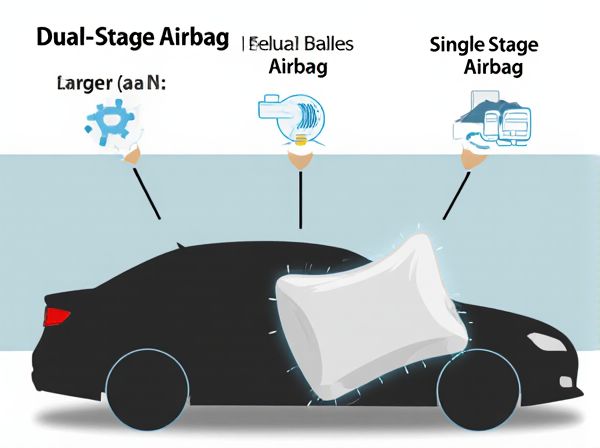
Photo illustration: Dual-Stage Airbag vs Single-Stage Airbag
Dual-stage airbags adjust deployment force based on crash severity, providing enhanced protection by reducing injury risk during low-impact collisions. Single-stage airbags deploy at a fixed pressure, which may not be optimal for all accident scenarios. Your safety can be significantly improved with dual-stage systems that tailor inflation to better protect occupants.
Table of Comparison
| Feature | Dual-Stage Airbag | Single-Stage Airbag |
|---|---|---|
| Deployment Stages | Two stages based on crash severity | One fixed deployment stage |
| Inflation Speed | Variable inflation speed | Constant inflation speed |
| Crash Severity Adaptation | Adjusts inflation to impact force | No adjustment to impact force |
| Safety Performance | Enhanced occupant protection | Basic occupant protection |
| Cost | Higher manufacturing cost | Lower manufacturing cost |
| Common Use | Modern vehicles, premium models | Older or basic vehicle models |
Introduction: Understanding Airbag Technologies
Dual-stage airbags deploy with variable force depending on the severity of a collision, enhancing occupant protection by adjusting inflation pressure. Single-stage airbags inflate with a fixed force regardless of impact intensity, providing consistent but less adaptable cushioning. Advances in sensor technology enable dual-stage systems to optimize safety while minimizing injury risks during various crash scenarios.
What is a Single-Stage Airbag?
A single-stage airbag is a safety device designed to deploy with one consistent level of force during a collision, providing basic occupant protection. Unlike dual-stage airbags, which adjust deployment pressure based on crash severity and passenger characteristics, single-stage airbags release a fixed amount of energy regardless of impact specifics. This simplicity in design makes single-stage airbags less adaptive but still effective in reducing injury in moderate to severe frontal crashes.
How Dual-Stage Airbags Work
Dual-stage airbags deploy with variable force depending on the severity of a collision, using sensors to assess impact speed and occupant position. They inflate in two phases: an initial partial inflation helps protect occupants in moderate crashes, while full inflation occurs during severe impacts to provide maximum cushioning. This technology enhances safety by reducing airbag-related injuries and adapting protection to crash conditions.
Key Differences Between Dual-Stage and Single-Stage Airbags
Dual-stage airbags deploy with variable force based on crash severity and occupant size, enhancing safety by reducing injury risk compared to single-stage airbags that inflate at a fixed rate. Dual-stage systems use sensors to determine the appropriate deployment level, while single-stage airbags provide uniform deployment regardless of collision intensity. The adaptability of dual-stage airbags offers better protection in both minor and severe crashes, optimizing occupant safety.
Safety Performance: Which Offers Better Protection?
Dual-stage airbags deploy with variable force based on the severity of a crash and occupant size, providing tailored protection that reduces the risk of injury in both minor and severe collisions. Single-stage airbags release at a fixed rate, which may be less effective in adapting to different crash scenarios, potentially increasing the chance of injury. Studies show dual-stage airbags enhance safety performance by optimizing impact energy absorption and minimizing occupant trauma compared to single-stage airbags.
Deployment Scenarios and Crash Sensitivity
Dual-stage airbags deploy at variable force levels depending on crash severity and occupant position, optimizing protection by reducing injury risk in moderate collisions while maximizing cushioning in severe impacts. Single-stage airbags deploy at a fixed inflation level regardless of crash intensity, which may increase the chance of injury in less severe accidents due to excessive force. Enhanced crash sensitivity in dual-stage systems allows for more precise deployment scenarios, improving overall occupant safety by adapting to specific collision dynamics.
Cost Comparison: Dual-Stage vs Single-Stage Airbags
Dual-stage airbags generally incur higher manufacturing and replacement costs compared to single-stage airbags due to their advanced sensors and deployment technology, which adjusts inflation based on crash severity. Single-stage airbags are less expensive because they deploy at a constant rate regardless of collision force, making them more cost-effective for budget-conscious buyers. Insurance premiums and repair expenses may also be lower with single-stage airbag systems, though dual-stage airbags provide enhanced occupant protection during varied impact scenarios.
Vehicle Compatibility and Model Availability
Dual-stage airbags offer enhanced deployment control based on crash severity, making them compatible with a broader range of modern vehicles equipped with advanced safety systems. Single-stage airbags provide a fixed deployment level and are typically found in older or entry-level models with basic safety features. Automakers increasingly favor dual-stage airbags for mid to high-end models due to regulatory standards and improved occupant protection.
Maintenance and Repair Considerations
Dual-stage airbags require specialized diagnostic tools to monitor and reset sensors due to their two-level inflation system, making maintenance more complex compared to single-stage airbags. Repair costs for dual-stage airbags tend to be higher because they involve additional components such as sensors and control modules that must be calibrated accurately. Single-stage airbags, with their simpler design, are generally easier and less expensive to service, reducing overall maintenance time and expenses.
Choosing the Right Airbag System for Your Needs
Dual-stage airbags deploy with variable force based on the severity of a collision, providing tailored protection and reducing the risk of airbag-related injuries. Single-stage airbags deploy with full force regardless of impact severity, offering consistent but less adaptive safety. Choosing the right airbag system depends on factors such as vehicle type, occupant size, and crash test ratings, ensuring optimal protection for your specific driving conditions.
 caratoz.com
caratoz.com